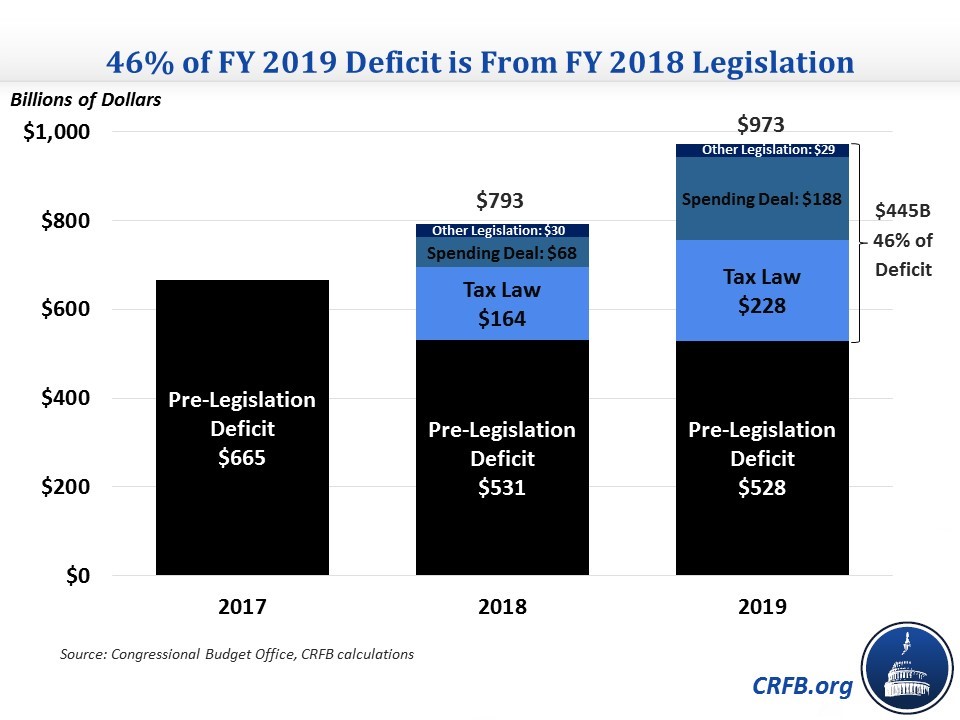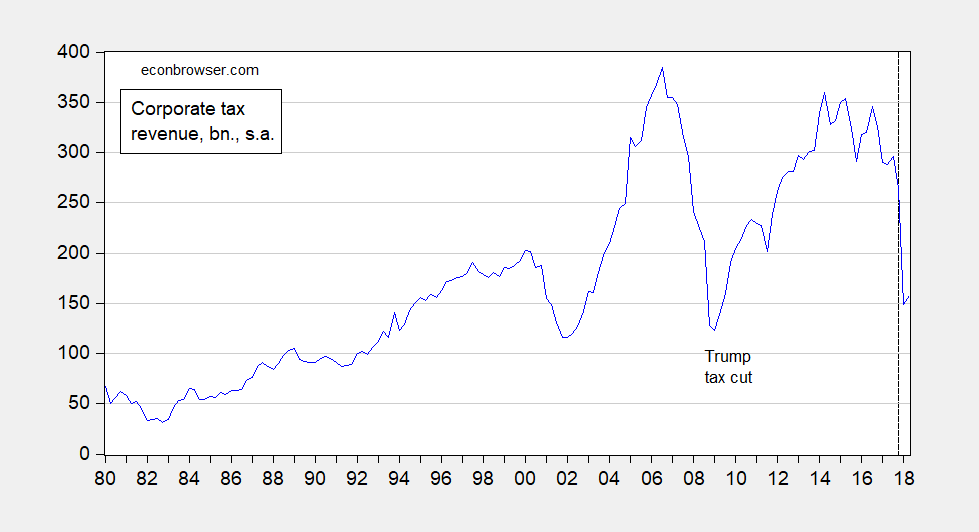The FY2019 projected deficit balloons, as the estimated “dynamic” effects of the Tax Cuts and Jobs Act prove minor (quelle suprise!)

Source: Committee for a Responsible Federal Budget.
For the actual, recorded effects on corporate tax receipts thus far:

Figure 1: BEA, 2018Q2 3rd release. [updated 9/29 2:22PM Pacific]
Isn’t the new tax law 46% of the deficit INCREASE?
As Reagan said – let’s replace tax&tax and spend&spend with spend&spend and borrow&borrow!
The left scale is $450 B while the right scale is $500 b.
spencer: Good catch. Left scale correct; they must’ve deleted 2nd series, forgot to delete right scale. Have taken data directly from BEA 2018Q2 3rd release and re-graphed, and posted.
And if politicians were paid as suggested below, there would be a vastly smaller deficit in all likelihood.
Incentives matter.
http://www.prienga.com/blog/2015/3/19/a-bonus-plan-for-politicians
And by the way, no one is talking about the likelihood of FICA goes from 15.3% of income to around 23% of income in the 2023-2026 time frame.
So corporate tax receipts dropped from 7% of total tax revenue to 3% ($150B/$3.4T). This doesn’t seem like a bad price to pay for the economic benefits.
A high price for virtually NO benefits. Or didn’t you even bother to read what Menzie wrote about this? Yes the supply side miracle and other Laughers from the University of the National Review!
sammy: Well, shouldn’t we normalize by the relevant tax component, so it’s a 50% decline…? and exactly where are you getting quantitative estimates for these putative “benefits”? Conventional dynamic scoring by the various groups (including JCT) does not indicate economic nirvana.
sammy to 3% ($150B/$3.4T).
Plenty of nonsense in your post, but I’m not following your arithmetic. Please explain to me how $150B works out to only 3 percent of $3.4T. Is that Fox math?
My Excel calls this at 4.4% not 3%. But we all know Sammy has a superior fuzzy math algorithm!
Menzie
You are more familiar with the CRFB than I am, so could you point to where the assumptions for the above graph were made and published. I did find the CRB link to the 2027 total deficit of ~1.9 trillion from the tax cut but could not quickly find the basis for the pre-legislation deficit amounts. Would you help?
Ed
Edward Hanson: My guess is that they use the CBO outlook (under current law) as of August 2017. So I suggest you go to An Update of the Budget and Economic Outlook, June 29, 2017.
Obviously time to balance the budget. First orders of business? Cut Social Security, Medicare, Medicaid. Increase defense spending. Enact another tax cut. Budget should be balanced by 2022 at the latest. Plenty of money available to “build that wall” too.
You forgot more farm subsidies.
Right! Additional subsidies will actually reduce deficits. Plus, unsold –or undersold–soybeans can add to student lunch nutrition. WINNING!
As evidence for the effects of corporate tax cuts I would reference the stock market and employment statistics.
Seriously? Employment as a share of population rose quite a but under Obama’s second term as did the stock market. But this tax cut was enacted at the end of 2017. Since then EPOP has basically flat lined. Call Stephen Moore as you need some better talking points.
And Sammy, the stock market is barely above where it was when the tax cut went into place. Most of the stock market gains were last year.
Barkley,
“Most of the stock market gains were last year.”
The stock market looks forward. It anticipated the tax cut, among other things.
what are the figures as a % of GDP?
I assume the proper authorities have informed Infomercial magnate Newt Gingrich and DUI Boehner of this “anomaly” in the Laffer Theory of the Cosmos??
Sammy wants us to look at the alleged employment boom since the Dec. 2017 tax cut. Let’s do look at the employment to population ratio:
https://fred.stlouisfed.org/series/EMRATIO
It did rise significantly from 2010 to September 2017. Since then – not so much. Not exactly proof of Sammy’s Laugher Curve – is it?
Reading Menzie’s post, he is trying to declare that the change of direction of government occurred with what he call the “2018 legislation.” This what you would expect from Keynesian economist combined with a highly partisan progressive. But the fact of the matter is, the real change happened in November 2016 with the election of President Trump. So let’s look at the projected budget deficit by the CBO closest to and before the election. (As Menzie directed me to the CBO) This will give a different perspective to the actual change of direction by the government. That would be the August 2016 “Projections of spending and revenues by category and of deficits and debt held by the public” by the CBO. The following are the projected deficits as of that time and the same years as posted by Menzie.
Year………..8/16 CBO…………Menzie’s numbers
2017…………$594 B………………….$665 B
2018…………$520 B………………….$531 B
2019…………$624 B………………….$528 B
Note the change in deficit projection for 2019. Almost 100 B less. And a direction of less deficit.
That is the difference between President Trump and more of the same from the progressive Dems. That is the difference of all of us having less tax money taken from our earnings. That is the difference of amazingly low unemployment rate, rising wages, and greater choice.
Above numbers can be found by clicking Aug 2016 under “10-Year Budget Projections”at:
https://www.cbo.gov/about/products/budget-economic-data#3
Ed
Edward Hanson: Not my numbers, CRFB’s. And I laughed and laughed when you implicitly called CRFB a “highly partisan progressive”. Someday, you will understand what “current law” means.
No Menzie,
I have to laugh. The highly partisan progressive” described was not implicit at all but quite explicit and it being, of course, you. But we can talk about cherry picking which and how statistics are to be repeated at another time.
But let’s talk about deflection now. You write of “highly partisan progressive,” you write of “current law,” but you avoid writing about the fact that President Trump administration has reduced the projected deficit as demonstrated by the fore mentioned CBO Aug 2016 estimates. Fortunately, many of the people still here after years recognized such deflection is a standard technique of your responses, and those who are new will soon see it; and realize why you resort to it.
Ed
Ed Hanson Your post doesn’t make a lot of sense. If you want a clearer look at the deficit picture and how it has changed under Trump’s tax cuts, let me suggest CBO’s “The Budget and Economic Outlook: 2018 to 2028”.
https://www.cbo.gov/publication/53651
Also, notice little tidbits, such as how FY2018’s budget deficit is $44B less than it otherwise would have been because of calendar effect; viz., 1 October fell on a weekend, so expenditures were paid in FY2017. Little technical things like that are important. The most recent CBO report shows that Trump’s tax cuts have blown a Yu-u-ge whole in the budget.
Edward Hanson: The difference between budget numbers you cite as being “mine” and the August 2016 numbers conflate economic, technical and legislative effects on the budget. If you want to see what happens because of TCJA and Omnibus Budget bill, then just go the the April 2018 Outlook, look to Table A-1 on page 92, and look at the legislative impact on the deficit. You will see in FY2019, the budget is worsened by -$459 billion. Economic impact on the deficit from the growth effect from tax cuts is described on page 93 as accounting for about half of the revenue effect (of $88 billion) [so there is dynamic scoring in this calculation]. So -$459+$44 = -$419, pretty close to the $446 cited in the CRFB calculations.
By the way, by doing the comparsison against August 2016, are you say all the other things Trump implemented before TCJA and the Omnibus Budget (Muslim ban, putting out bids for the Wall with Mexico, selling arms to Saudi Arabia) stimulated the economy measurably?
Slug and Menzie
Sorry to be so long to get back but I have been busy for a change.
First, and as you well understand and are attempting to deflect from, my post was not been about the total deficit but of the part of Menzie’s post called Pre-Legislation Deficit. It is by far the largest contribution to the deficit and has been remarkably reduced since President Trump came into office. To expand on my post I will present more and later projections of the deficit from the Pre-Legislation time by the CBO. Again all can be found by clicking for the information at:
https://www.cbo.gov/about/products/budget-economic-data#3
Year………..8/16 CBO……1/17CBO……6/17CBO……Menzie’s numbers
2017…………$594 B…………$559 B……….$691 B……………$665 B
2018…………$520 B…………$558 B……….$690 B……………$531 B
2019…………$624 B…………$557 B……….$689 B……………$528 B
As can be seen, the Pre-Legistion component of the deficit in the Menzie column is shows great reduction from the the actual $665B (pre-legislation in 2017).
The reduction is even more remarkable when compared to the CBO expectations of that component rising steeply each year.
The reduction of this component further demonstrates the success of the Tax Cut Bill and the regulatory reductions.
To finish, I do not have objection to discussing the total deficit. But that is better discussed at the time the actual 2018 numbers are published, which will be soon.
Ed
P.S. Menzie wrote, “By the way, by doing the comparsison against August 2016, are you say all the other things Trump implemented before TCJA and the Omnibus Budget (Muslim ban, putting out bids for the Wall with Mexico, selling arms to Saudi Arabia) stimulated the economy measurably?”
Enough of the political Menzie, your post was from the economist Menzie. As stated the legislation by you is the TAX Cut Bill and the bipartisan Budget Bill. I through in the Regulatory restructure because it is important economically. Your political mentions in the quote are of no consequence.